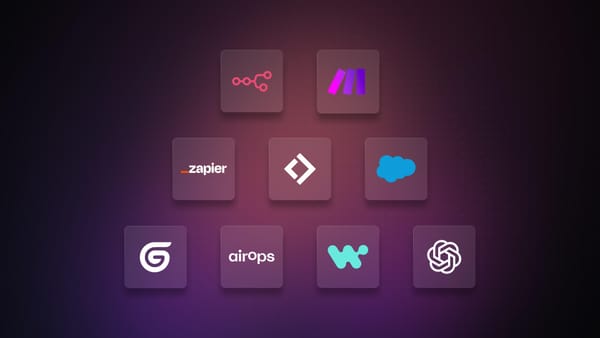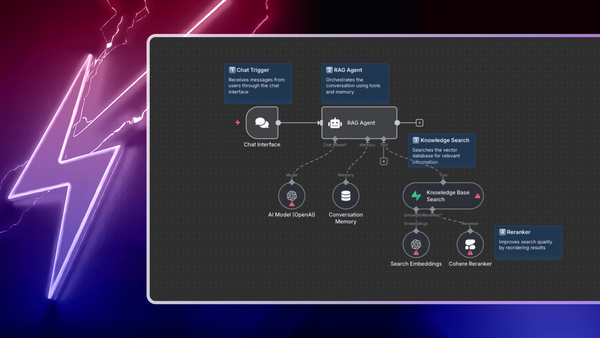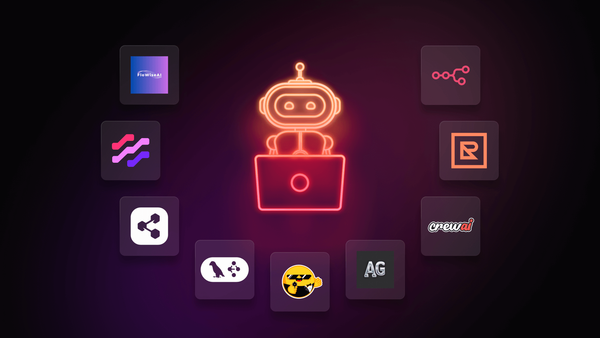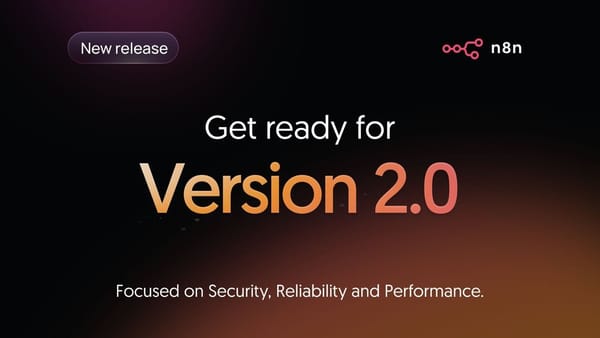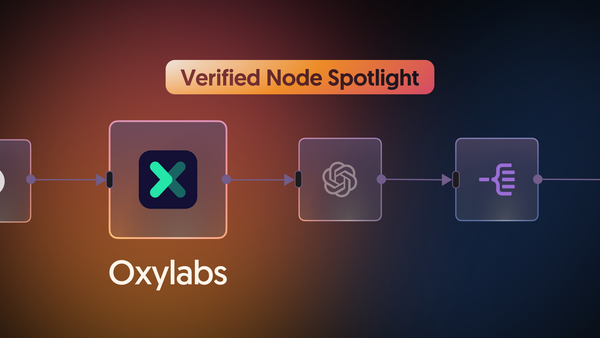In today's enterprise landscape, while most organizations are just beginning to explore basic AI implementations, a quiet revolution is taking place. Large Language Model (LLM) agents are emerging as game-changers, combining advanced reasoning capabilities with practical automation. These sophisticated systems can plan multi-step operations, maintain context across complex tasks, and even learn from their interactions — capabilities that go far beyond traditional AI implementations.
In this article, you will learn what makes LLM agents different from legacy AI systems, discover their core components, and see how you can create and deploy them using n8n — a powerful workflow automation platform.
Whether you're a security professional looking to enhance threat detection, an IT manager aiming to streamline operations, or a DevOps engineer interested in automating complex workflows, this guide will show you everything you need to know about leveraging LLM agents in your enterprise environment.
What is an LLM Agent?
At its core, an LLM agent is an advanced AI system that combines the language understanding capabilities of large language models with strategic planning and tool integration. Unlike simple AI models that respond to prompts, LLM agents can break down complex tasks, plan their execution, and use various tools to accomplish their goals—much like a skilled professional approaching a multi-faceted project.
Think of an LLM agent as a digital team member with three key capabilities:
- Strategic planning: An LLM agent can analyze complex requests and break them down into logical, sequential steps. For instance, when tasked with investigating a security incident, it can automatically plan the investigation stages, from initial log analysis to impact assessment.
- Memory and context management: Unlike standard chatbots, LLM agents maintain context across interactions and tasks. They can reference previous decisions, learn from past actions, and apply this knowledge to current situations—crucial for maintaining consistency in enterprise operations.
- Tool integration: Perhaps most importantly, LLM agents can interact with various enterprise tools and APIs. Whether it's querying security logs, updating ticketing systems, or analyzing performance metrics, they can leverage existing infrastructure to complete tasks.
Legacy AI systems vs. modern LLM-powered agents
The evolution from legacy AI systems to modern LLM-powered agents represents a fundamental shift in enterprise automation capabilities:
This evolution enables enterprises to automate increasingly complex tasks that previously required significant human intervention. LLM-powered agents can handle nuanced situations, understand context, and even explain their reasoning—capabilities that were impossible with legacy systems.
What are the core components of LLM agents?
An LLM agent consists of four essential components that work together to create a sophisticated automation system. Understanding these components is crucial for enterprise teams looking to implement and leverage LLM agents effectively.
Agent/Brain
The brain of an LLM agent is built on advanced language models that serve as its cognitive center. This core component:
- Language model foundation: Uses state-of-the-art LLMs to understand and process natural language inputs, enabling communication with users in their own terms rather than requiring specialized commands.
- Processing capabilities: Analyzes complex information streams, from unstructured text to structured data, making it valuable for handling diverse enterprise data sources.
- Decision-making mechanisms: Employs sophisticated algorithms to evaluate options and select appropriate actions based on context, goals, and constraints.
Memory systems
LLM agents utilize two types of memory systems that enable them to maintain context and learn from experience:
- Short-term memory:
- Maintains context during ongoing interactions
- Tracks current task progress and intermediate results
- Holds temporary variables and state information
- Long-term memory:
- Stores historical interactions and outcomes
- Maintains knowledge bases of previous solutions
- Preserves learned patterns and best practices
Enterprise applications of these memory systems include maintaining context across complex IT workflows, remembering previous incident resolutions, and building organizational knowledge bases over time.
Planning capabilities
The planning component enables LLM agents to approach complex tasks systematically:
- Task decomposition:
- Breaks down complex requests into manageable subtasks
- Identifies dependencies between different steps
- Prioritizes actions based on urgency and importance
- Plan formulation:
- Creates structured workflows for completing tasks
- Sets checkpoints for monitoring progress
- Establishes success criteria for each step
- Adaptation and reflection:
- Adjusts plans based on new information or changing conditions
- Learns from successful and unsuccessful approaches
- Improves strategies through experience
Tool integration
The tool integration component allows LLM agents to interact with enterprise systems:
- Available tools and APIs:
- Integration with common enterprise software
- Access to databases and knowledge bases
- Connection to monitoring and alerting systems
- Integration capabilities:
- Seamless data exchange between systems
- Standard protocol support (REST, GraphQL, etc.)
- Real-time synchronization capabilities
- Security considerations:
- Role-based access control
- Audit logging of all actions
- Secure credential management
- Data encryption in transit and at rest
Together, these components create a flexible and powerful system capable of handling complex enterprise tasks. The effectiveness of an LLM agent depends on how well these components are implemented and integrated within your specific environment.
How can n8n-powered LLM agents elevate your automation workflows?
The rise of LLM agents has revolutionized how we approach automation. Unlike static automation systems that follow rigid rules, n8n-powered LLM agents can intelligently adapt to dynamic scenarios, analyze intricate datasets, and interact seamlessly with various tools and platforms. They act as smart assistants that not only save time but also enhance decision-making and streamline operations.
- Intuitive workflow design: n8n’s visual builder makes it simple to create even the most complex AI agent workflows, without requiring deep coding knowledge.
- Comprehensive integrations: With an extensive library of integrations, n8n allows your AI agents to connect with diverse APIs and data sources effortlessly.
- Advanced AI integration: Leverage the power of leading AI tools like OpenAI, Google Cloud, and others to build intelligent and context-aware workflows.
- Event-driven execution: With support for real-time triggers and webhooks, your AI agents can respond immediately to external inputs.
- Data processing and analysis: n8n provides robust tools for transforming, analyzing, and contextualizing data, enabling AI agents to make well-informed decisions.
Let’s explore some of the ready-to-use workflows with LLM agents available in n8n’s template library. These examples illustrate how AI agents can revolutionize processes like virtual assistance, real-time monitoring, and data-driven decision-making.
Workflow example 1. Chat with files
If you’re juggling a mountain of documents and need a faster way to find what you’re looking for, the AI-Powered Document Querying Workflow is here to help. This clever tool takes the hassle out of managing and searching through files by automating the hard parts:
- File retrieval: It grabs files from your Supabase bucket and skips over duplicates or placeholders.
- Content extraction: It processes PDFs and text files, pulling out all the important content.
- Text chunking: It breaks down large chunks of text into smaller, manageable pieces, keeping the context intact.
- Vector embedding: It uses OpenAI to create vector embeddings, making your documents searchable in a smarter way.
- Data storage: And finally, it stores everything neatly in Supabase, ready for a chatbot to answer your questions.
This workflow is perfect for researchers, business owners, or anyone who works with big collections of text-heavy files. Instead of spending hours digging for information, you can just ask a question and get the answer, all thanks to the chatbot integration.
Workflow example 2. YouTube trend finder
If you’re curious about what’s trending in a specific niche, this workflow is your go-to tool. By tapping into YouTube’s search and data APIs, it analyzes the performance of recently published videos to uncover emerging trends and patterns. Here’s what it does:
- Start with a question: The workflow kicks off when you provide a niche or topic through a chatbot. If you’re unsure, the AI can help refine or suggest search terms to get you started.
- AI-driven insights: A GPT-powered AI processes your input, generates targeted search terms, and dives into the data to identify common themes, audience interests, and engagement metrics.
- Real-time search: It scans YouTube for videos uploaded in the last two days, retrieving relevant details like video titles, tags, and publication dates.
- Data analysis: The workflow organizes the data, cleans it up, and analyzes trends across the content, such as recurring themes, popular tags, and engagement patterns.
- Actionable results: It presents a concise summary of what’s trending, complete with URLs to top-performing videos and key stats like views, likes, and comment ratios.
For example, in the niche of “digital marketing,” it might highlight topics like “psychological marketing” and tags such as “SEO” or “Conversion Rates,” along with links to high-performing content.
Workflow example 3.Vision-based scraper
If you’re tired of wrestling with XPath, CSS selectors, or the intricacies of DOM structures when scraping, this workflow is your new best friend. It’s powered by a vision-based AI agent that makes data extraction feel effortless, whether from screenshots or HTML.
Here’s what makes this workflow so effective:
- Smart AI data extraction: Using the Gemini-1.5-Pro model, the workflow processes screenshots to grab structured data. If needed, it switches to HTML scraping, so you always get accurate results.
- Seamless Google Sheets integration: You can manage the list of URLs to scrape and store the results directly in Google Sheets for easy access and organization.
- ScrapingBee magic: This tool handles full-page screenshots and HTML retrieval, ensuring every detail is captured.
- Cost-saving optimization: By converting HTML to Markdown, the workflow minimizes token usage, keeping processing efficient and affordable.
Originally designed for e-commerce, this workflow can be adapted to fit a variety of use cases, whether you’re extracting product details, research data, or anything in between.
Workflow example 4. Suggest meeting slots
Managing appointment requests in your inbox can be a hassle, but this workflow takes care of it all for you. It’s designed to automatically identify emails asking for an appointment, check your availability, and send a thoughtful response—all without you lifting a finger.
Here’s how it works:
- Smart email detection: The workflow scans your Gmail inbox for emails requesting appointments. It evaluates the content to understand the request and extract relevant details.
- Calendar integration: It checks your calendar for available slots, ensuring you don’t accidentally double-book or overcommit.
- Automated replies: Once availability is confirmed, the workflow drafts and sends a polished response email with your proposed time.
This workflow is perfect for busy professionals, freelancers, or anyone who deals with frequent appointment scheduling. It saves time, reduces back-and-forth, and ensures no request slips through the cracks.
Workflow example 5. Sales researcher
For sales reps and lead generation managers, preparing for prospecting can often feel like a time-consuming grind. This workflow is here to streamline that process, helping you gather the essential information you need to personalize your outreach and make meaningful connections.
Here’s what it does:
- AI-powered account research: Using advanced AI tools, this workflow searches Google with SerpAPI and visits websites to extract key information—all from just a company name or domain.
- Comprehensive insights: The workflow gathers details like:
- The company’s LinkedIn URL
- Pricing information (cheapest plan, free trial availability, enterprise options)
- Whether the company offers an API
- Their target market (B2B or B2C)
The real magic? You can tweak this workflow to gather whatever information you need. By simply adjusting the AI prompts and output structure, it can be tailored to suit your exact research goals.
It replaces the hours of manual research sales teams typically spend preparing for prospecting activities, letting you focus on connecting with leads instead of hunting for data.
How to create an LLM agent workflow with n8n?
Now that we’ve explored various n8n workflows, let’s dive in and build one together!
This time, we’ll create a powerful AI-driven chatbot that connects to the internet and Wikipedia, making it an incredible tool for quick information retrieval and answering complex questions. Whether you’re a researcher, a customer support agent, or just someone who loves having an all-knowing assistant at their fingertips, this workflow is a game-changer.
What makes this chatbot special is its ability to pull live information from the web and Wikipedia, ensuring you always get up-to-date and accurate answers. It’s like having a personal researcher working for you around the clock!
In just a few simple steps, you’ll set up a conversational agent that can handle a variety of queries, retrieve relevant data, and respond in a human-like way. And once you have the basics in place, you can customize it further—maybe by connecting it to other databases, adding filters for specific types of content, or even integrating it into your favorite messaging app.
Ready to build your own intelligent assistant? Let’s get started!
Step 1: Chat trigger listens to incoming messages
For Chatbots we use a chat trigger to start it. In this case, for experimentation purposes, a manual trigger. Later you can then test the workflow by clicking chat on the bottom of your canvas.
Step 2: AI Agent node processes incoming messages and decides which tools to use
You need to connect a main AI Agent node to the trigger. This is the central node for this workflow and you can define the “Agent Type”, “Prompt Source” & “Text”. In this case we use the input from the trigger “{{ $json.input }} as the input text for the Agent.
Step 3: OpenAI powers our LLM Agent
You need to connect a chat model to your AI Agent node. For this purpose we use OpenAI as a model provider, but technically you can use whichever provider you prefer (from the supported ones). The only parameter you can manually change here is the “Sampling Temperature”. It controls the randomness/creativity of the model. It affects how likely the model is to pick words with lower probabilities from its prediction distribution. Our recommended temperature of 0.3 leads to more conservative & predictable outcomes.
Step 4: The last 20 messages should be remembered
We also need to connect a kind of memory storage, for the chat history to be stored inside the workflow. We use Window Buffer Memory, as it is the simplest and beginner-friendliest way to do so and select 20 as the number of past interactions that should be saved in this memory storage.
Step 5: SerpAPI & Wikipedia as tools to use
In n8n we can select multiple tools that then can be used by the AI Agent during execution. You don’t need to configure anything here, as n8n handles the heavy lifting. For this example, we use SerpAPI & Wikipedia to make our chat agent smarter with up-to-date information.
By following these steps, you'll create your first LLM Agent powered by n8n, OpenAI, Wikipedia and SerpAPI.
Best practices and considerations when building LLM agents
As you dive into building and deploying your workflows, there are a few important aspects to keep in mind to ensure a smooth, secure, and efficient experience. Let’s break it down into two key areas: security and performance optimization.
Security implications
- Data privacy: When handling sensitive or personal data, always prioritize privacy. Ensure that your workflows comply with local data protection laws (like GDPR or CCPA). Be mindful of how you collect, store, and share information to avoid unauthorized access or breaches.
- Access control: Implement robust access control mechanisms to restrict who can view, modify, or trigger workflows. Whether it's through API keys, OAuth, or other authentication methods, controlling access ensures that only authorized users can interact with your workflows.
- Compliance considerations: If you're dealing with regulated industries, it's essential to understand the compliance requirements (e.g., healthcare, finance). Make sure your workflow adheres to these standards to prevent legal or financial complications down the line. This could include keeping logs of actions, using secure data transmission, or encrypting sensitive information.
Performance optimization
- Resource management: To avoid inefficiencies and potential bottlenecks, manage resources effectively. This includes limiting the number of operations or API calls to prevent overloading the system. Set up error handling and retry mechanisms to maintain reliability even when resources are stretched thin.
- Scaling strategies: As your workflows grow in complexity or volume, scalability becomes crucial. Design your workflows with scalability in mind by breaking them into smaller, modular components. Use cloud services that allow for auto-scaling to accommodate spikes in traffic or data processing needs.
- Cost considerations: Keep an eye on the costs associated with running automated workflows, especially if you’re using third-party services like APIs or cloud storage. Optimize your workflows to minimize unnecessary operations and data transfers. Regularly review your usage patterns and adjust workflows to keep them cost-efficient without sacrificing performance.
By focusing on these best practices, you’ll be able to build workflows that are not only efficient and effective but also secure, scalable, and cost-conscious. Always keep these considerations in mind as you iterate and expand your automation projects.
Wrap up
In this guide, we’ve explored the transformative potential of Large Language Model (LLM) agents, diving into their core components and capabilities.
LLM agents combine advanced reasoning with practical automation, offering enterprises the ability to streamline complex workflows, adapt dynamically to new tasks, and interact intelligently with various tools and systems.
Using n8n as the platform, we’ve demonstrated how LLM agents can be integrated into workflows to handle tasks ranging from real-time data retrieval to complex decision-making. With n8n’s visual workflow builder, powerful integrations, and advanced AI tools, creating an intelligent agent becomes accessible, even for those without extensive coding experience.
What's next?
Ready to take your LLM agents to the next level? Whether you want to fine-tune your workflows, integrate additional tools, or scale your solutions for enterprise use, the next steps are just as exciting as the first.
There’s always more to explore when it comes to building smarter, more efficient automation systems:
- Finding the scaling Laws of Agents: dive into multi-agent systems;
- n8n templates with LLM Agents: discover more use-cases;
- AI Agent n8n documentation: go beyond the n8n capabilities we have shown in this blog by reading through the documentation.


